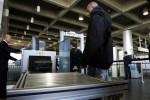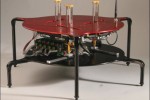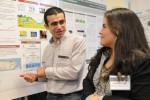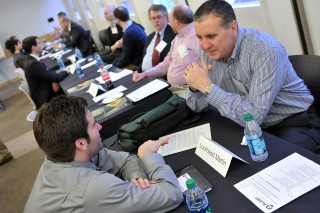News & Events
Industry
Connections are made at ASPIRE March 28, 2013

The ALERT COE and its predecessor, the Bernard M. Gordon Center for Subsurface Sensing and Imaging Systems has had a thirteen year history of close collaboration with our industrial partners. To continue this tradition, we have instituted a new annual event, the Annual Student Pipeline Industry Roundtable Event otherwise known as ASPIRE.
ASPIRE’s goal is to have our industrial partners introduce their companies, their products, and their future needs to one another, to our faculty, and to our student population. Held on March 19, 2013, ASPIRE started with 10-minute presentations by our industrial members, followed by short 2-minute presentations by students. It culminated in a two-hour networking session, consisting of twelve 10 minute “roundtable” discussion slots that companies and students selected as part of the registration process.
The initial feedback from both the industry and our student population has been extremely positive. Four of our small company members have scheduled follow-on meetings with our large member companies, such as Analogic, Raytheon and Siemens. Siemens Corporate Research is also interviewing ALERT graduate students for five new positions. Many of our participants have requested that ASPIRE be held semiannually.
Through such events, ALERT hopes to create closer collaboration amongst our industrial base, while finding the “right” match for our students and partner institutions. We expect that such alliances will respond with agility to future market opportunities as well as government BAAs and RFPs, thereby fostering effective technology transfer.
[photo credit: Craig Bailey/Perspective Photo]
ADSA09 – Call for Speakers February 4, 2013

ALERT is actively looking for speakers for the ADSA09 – Ninth Workshop for Algorithm Development for Security Applications: New Signatures for Explosive Detection for Aviation Security. This event will take place on May 7-8, 2013 at Northeastern University’s campus in Boston, MA.
Read More
ALERT presents the first installment of ALERT 101: Airport Screening Technologies December 1, 2012

We invite you to watch the first episode of ALERT 101 which focuses on the applications of Millimeter Wave Scanning and Backscatter X-ray in Airport Security Screening.
For users without YouTube access: ALERT 101: Airport Screening Tecnologies
Inspired by the success of TED (www.ted.com) and other educational media forums, ALERT has developed the ALERT 101 video series. Each video short will feature different technologies and research areas that the ALERT Center engages in. We hope that these productions help educate and inform the global community on these topics in an accessible and enjoyable way.
ALERT welcomes United States Secretary of Homeland Security, Janet Napolitano November 19, 2012

Awareness and Localization of Explosives-Related Threats was pleased to host U.S. Secretary of Homeland Security, Janet Napolitano on Monday, November 12th following her keynote address at Northeastern University’s Veteran’s Day Ceremony.
To kick off the visit, ALERT’s Director, Professor Michael B. Silevitch, provided Secretary Napolitano with an overview of the ALERT Center of Excellence. Prof. Silevitch then introduced undergraduate and graduate students involved with ALERT research and gave a summary of the demonstrations in video analytics and advanced imaging technologies that were prepared for her briefing. Michael described Napolitano’s visit as a significant opportunity for ALERT and its homeland security research, saying,
“It was very important to get validation from Secretary Napolitano about the relevance of our research and its transition to the field in the areas of video tracking of threats and passenger screening. This acknowledgement inspires us.”
Professor Octavia Camps led the first demonstration featuring ALERT’s Engage to Excel (E2E) Video Analytic Surveillance Transition project, VAST. VAST is a program developed in partnership with Siemens and the Cleveland Transportation Security Administration. The live demonstration exhibited the video analytic counter-flow program developed by Dr. Camps and her team and its ability to automatically detect when a person is proceeding the wrong way in an identified traffic pattern (for example, trying to enter through an exit). The resulting detections enable quick identification of an incident and minimize the impact on TSA resources. This project is currently installed within the Cleveland Hopkins International Airport.
Following the video analytics demonstration, Professor Carey Rappaport showed Secretary Napolitano the capabilities of the ALERT Advanced Imaging Technologies (AIT) laboratory. This laboratory fuses together various scanning tools to create next-generation security scanning systems. Professor Rappaport, Assistant Professor Jose Martinez and graduate student Spiros Mantzavinos demonstrated the operation and data acquisition capabilities of ALERT’s advanced portal-based millimeter-wave imaging radar. During the demo, the system scanned a mannequin wrapped in a skin simulant with various representative objects attached for detection. These types of AIT systems can be used to detect illicit items that passengers may be attempting to carry on their person.
“As a DHS-supported researcher, I found Secretary Napolitano’s visit very satisfying,” Prof. Rappaport commented. “She was of course quite knowledgeable about the science and technology we are pursuing, but she seemed keenly interested in how we were improving the state of the art. She was completely supportive and she motivated the students with her passion to keeping Americans safe.”
Spiros Mantzavinos, currently a Northeastern University Doctoral Candidate in Electrical and Computer Engineering and Gordon Engineering Leadership Fellow, had the opportunity to meet Secretary Napolitano. Mantzavinos said, “It was an honor to host Secretary Napolitano for a visit to our ALERT whole-body imaging lab. Receiving attention and recognition from such a prominent figure in the national security arena assures the relevance of the advances we are making.”
An Introduction to the Research and Industrial Collaboration Conference (RICC) October 3, 2012
For more than a decade, the RICC has fostered in-depth dialog among members of the academic, industrial and government communities interested in collaboration in subsurface sensing and imaging and homeland security related topics. This video, taken at the 2011 RICC, provides an overview of the successful event from the perspective of its participants.
Nextgov.com spotlights ALERT partnership with L3 October 3, 2012

The Homeland Security Department has funded a $1.1 million project at Northeastern University to advance the technique of using medical CT scans for bomb detection.
The research will be aimed at modifying computer tomography systems to automatically recognize explosives and items that can be used for detonation, according to federal business databases.
Read MoreALERT@NU hosts FEMA Region 1 Research to Resilience Workshop September 28, 2012

ALERT at Northeastern is proud to have hosted the FEMA Region 1 “Research to Resilience” Workshop held in Boston, MA on September 27, 2012. More than 200 attendees and 11 DHS Centers of Excellence (COEs) participated in this event.
The Research to Resilience Workshop was developed to link local and government agencies with DHS Centers of Excellence (COEs) in hopes of accelerating the transition of center developed research and education to improve preparedness. This inaugural event was administered through the Department of Homeland Security (DHS) Science and Technology Directorate Office of University Programs and FEMA Region 1.
ALERT co-director, Prof. Michael B. Silevitch, gave one of the opening presentations for this half-day workshop. The day included discussions about establishing a framework for transition, examples of successful partnerships, a research showcase, and a tabletop exercise to work through the process of transitioning specific COE technology into use.
During the research and technology showcase, the COEs displayed their research achievements at 17 different booths, holding more than 30 hands-on demos for attendees. ALERT at Northeastern showcased its tools developed in video analytics, IED detection, and explosives detection sensors. ALERT at University of Rhode Island also made a strong showing in areas including the development of blast-resistant materials.
ALERT, Square One partnership leads to NSF Small Business award August 6, 2012

ALERT researchers at Northeastern University partnered with Square One Systems Design to win a National Science Foundation Engineering Research Center – Small Business award in the area of automated landmine detection. This promising partnership leverages the strengths of academic and industry experts for a project with broad humanitarian and research potential
The partnership involves pairing Square One’s Walking Tri-Sphere (WTS) robot with ALERT’s Ground-Penetrating Radar solution. The WTS robot has the ability to autonomously negotiate rugged terrain, making it well suited for operating in a buried explosives environment, but object detection was a missing critical component. ALERT deputy director Carey Rappaport and researcher Jose Martinez are leading the Northeastern team in developing an effective and inexpensive Ground-Penetrating Radar (GPR) solution. If successful, the combined GPR-WTS system will enhance automated characterization of subsurface environments.
Current methods of demining involve slow and dangerous manual probing, or use very expensive and often delicate advanced technology. Square One and ALERT hope that this partnership will blaze a path toward fully automated demining operations and serve as a jumping off point to other significant subsurface characterizations.
In addition to the humanitarian benefits, this partnership creates a wealth of opportunities for student participation. Graduate and undergraduate students at Northeastern are actively involved in this cutting-edge design project, participating in computational modeling, reconstruction algorithm development, and antenna design and testing aspects.
Northeastern Ph. D. student Margery Hines, working with Carey Rappaport, won judges’ choice in the 2012 National NSF IGERT Online Video & Poster competition for her presentation of a computational study that demonstrated an ability to locate both metallic and non-metallic anti-personnel landmines.
.
Be one of the first to back FoRCE – a new product for Data Recovery July 6, 2012

Keith Bertolino, CEO and co-founder of Cipher Tech Solutions, and former Gordon Engineering Leadership student, is launching the prototype of FoRCE. Using an advanced method of digital forensics called “carving,” FoRCE would give even non-savvy computer users the ability to recover large amounts of deleted images, text, and other data files from Windows computers. In order to fund this project, Keith is leveraging Indiegogo to crowdfund his prototype.
RICC Presentations & Posters Now Available for Download December 9, 2011

Selected presentations and posters are now available for viewing on the RICC website.

